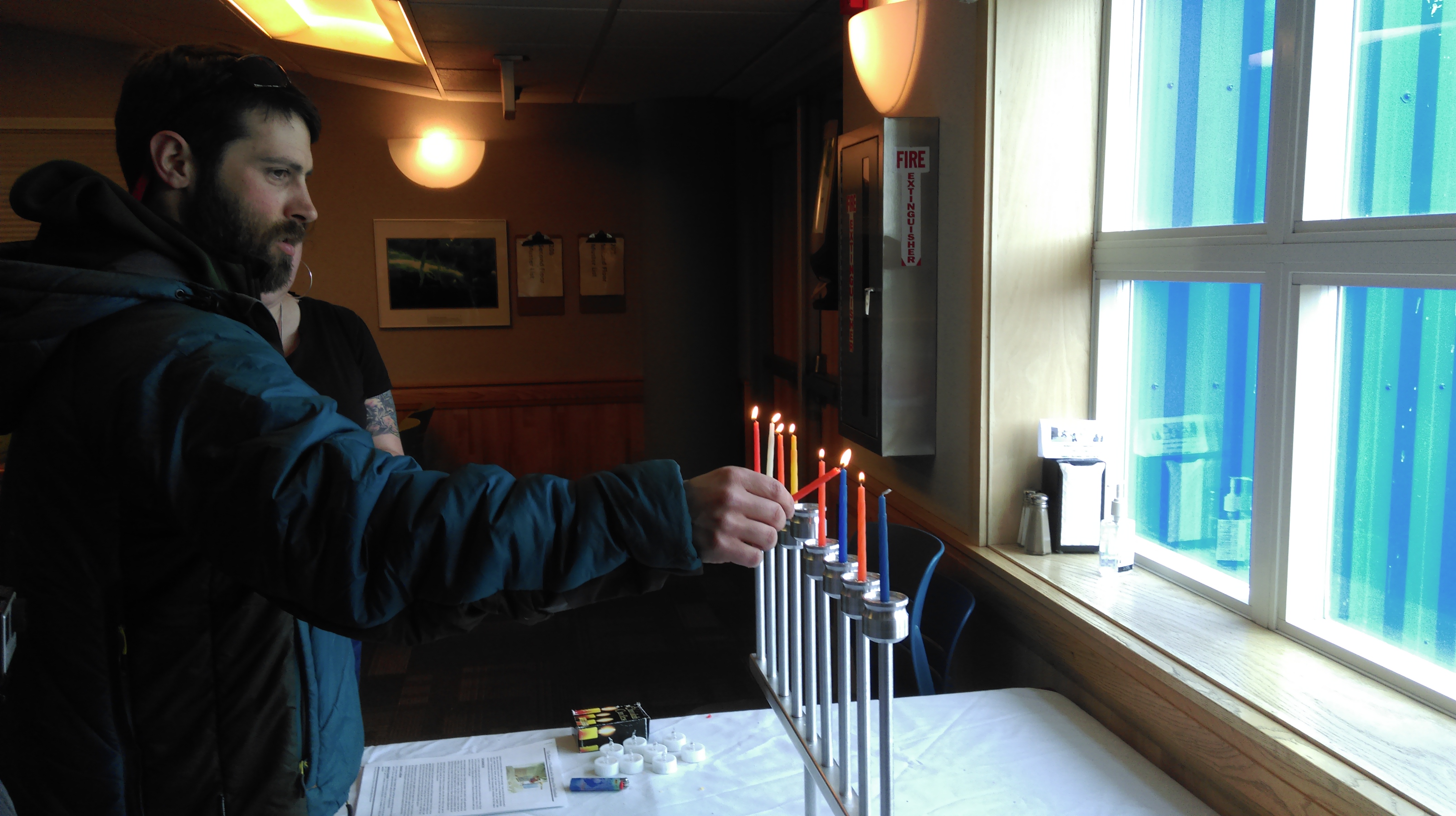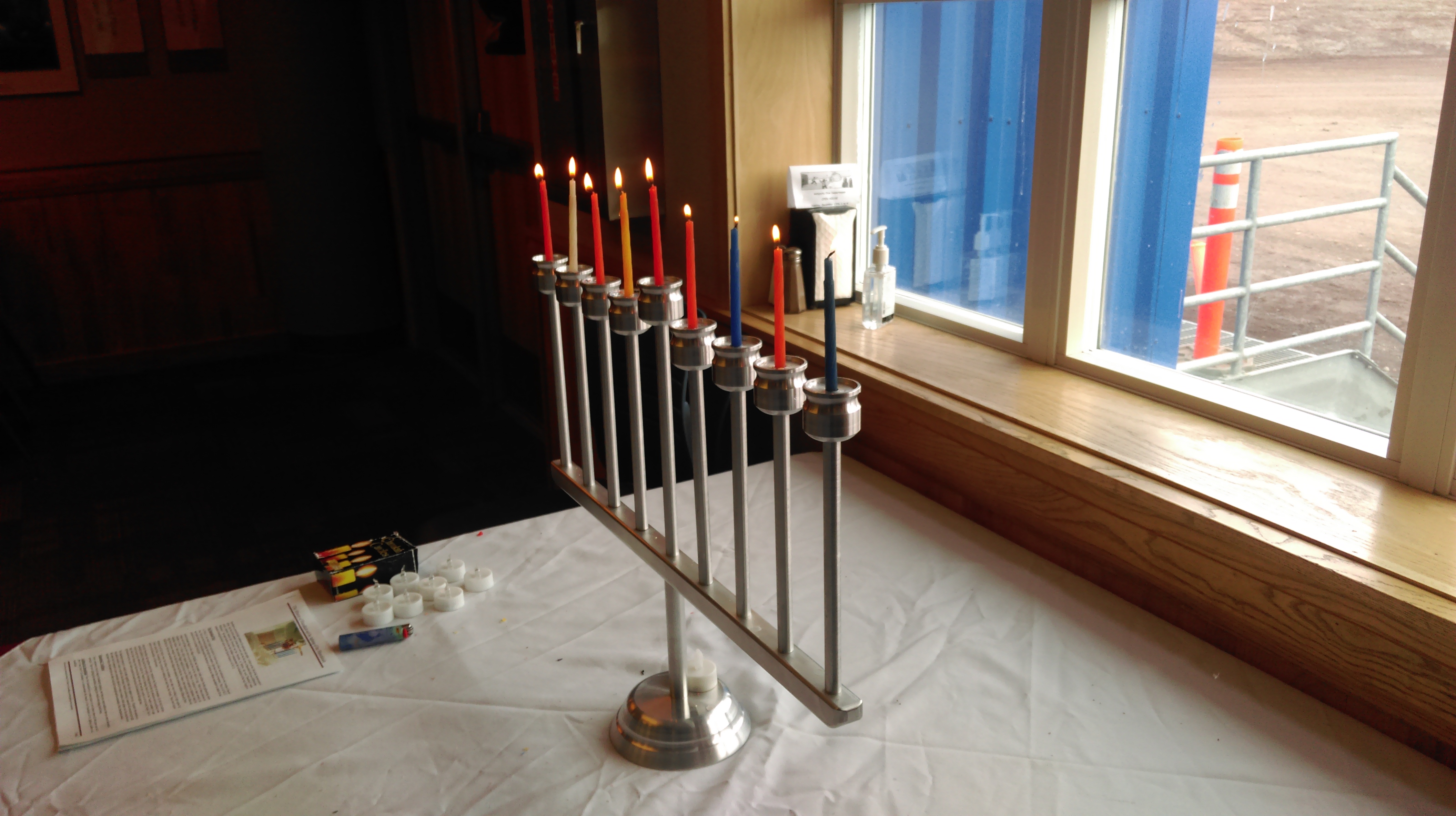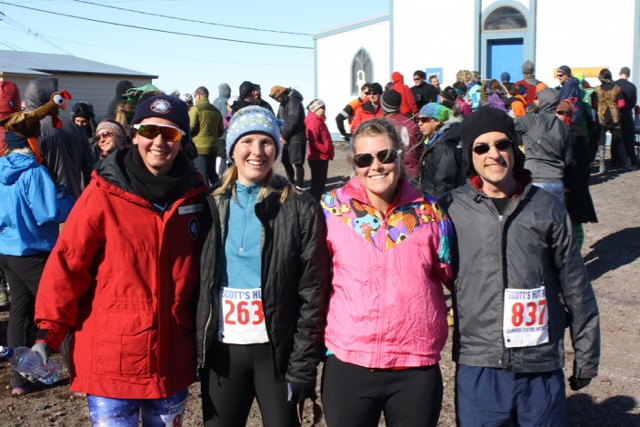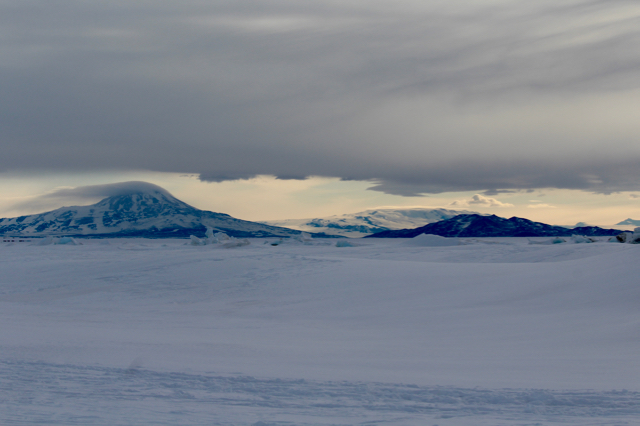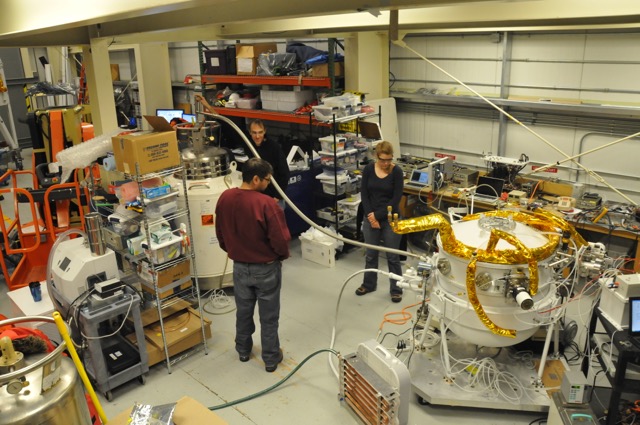A behind-the-scenes look at my life and work as a researcher in Antarctica, and the science, engineering, and technology that brought me here.
Southern Exposure | December 16, 2015
The Anticyclone
Why go to Antarctica to fly balloons? The answer is the anticyclone that sets up over the continent in December. The anticyclone is a weather system in the upper atmosphere in which the winds flow counter-clockwise around the continent. The wind flow can keep balloons afloat for long flights and allow for recovery of the payload so it can be flown again.
Each rotation around the continent is approximately 14 days. These wind patterns typically set up around December 15, although they can be ready as early as December 5 or as late as December 25. This year, the winds are expected to be in place around December 18, so in just a couple of days. The anticyclone pattern usually lasts one to two months, and some payloads teams will often try for two or three trips around the continent. The longest flight was 55 days.
TAGS: STO-2, ANTARCTICA, MCMURDO, ASTRONOMY, ASTROPHYSICS, BALLOONING
Southern Exposure | December 13, 2015
Hanukkah in McMurdo
Since the Antarctic summer season falls over a number of holidays including, Thanksgiving, Hanukkah, Christmas, and New Year's, people are interested in how the holidays are celebrated down here. I have written a post on Thanksgiving. The next holiday to be celebrated is Hanukkah. It is not the most important holiday on the Jewish calendar, but has grown to prominence in the United States because it falls around the same time as Christmas. Part of the holiday is to light a candle for every night of the holiday such that on the first night, one candle is lit, on the second night, two candles are lit, and so on and so forth. Technically, lighting candles is strictly forbidden at McMurdo. For this reason, the base requested special permission to allow a celebration. Permission was granted for one menorah to be lit only in the McMurdo galley, and the fire marshal had to be present. (The menorah is the base that holds all of the candles. There is a special one for Hanukkah with space for nine candles -- one candle for each night of Hanukkah and one candle to light all of the others.)
The most interesting thing about celebrating Jewish holidays in Antarctica is deciding when they actually start. Under the Jewish calendar, all days start at sundown, but during the Antarctic summer, the sun never sets. And there was no actual consensus about when the candle lighting should take place. I had heard that it was celebrated based on the closest land mass where the sun actually sets (i.e., New Zealand). Someone else said we should celebrate with Jerusalem, and yet a third said we should celebrate based on our home time back in the US. Ultimately, though, we just had to go with the time that the fire marshal was available, which was 7:15 p.m. There was also a nice party with latkes, matzah ball soup, the retelling of the Hanukkah story, and dreidel on the fifth night. Overall, I had a very nice holiday! Happy Hanukkah!!!
Southern Exposure | December 3, 2015
STO-2 Instrument
The project I came to Antarctica to work on, the Stratospheric Terahertz Observatory II, or STO-2, is a balloon-borne mission designed to trace the phases of the interstellar medium, which is the gas and dust between the stars. This gas and dust follows a life-cycle that can be traced with atoms such as carbon, nitrogen, and oxygen. These elements radiate in the terahertz (THz) region of the electromagnetic spectrum, which is the region between microwaves and infrared, hence the name Stratospheric Terahertz Observatory (it is our second flight, hence the II).
The STO-2 instrument is specifically designed to look at the star forming phase of the interstellar medium. Each atomic tracer transmits its own spectral signature, which can be thought of as its own radio station. We build radio receivers specifically tuned to look at each of the frequencies being emitted by the tracers. The technique used is called heterodyne detection and it mixes two signals near the same frequency to provide extremely high spectral resolution (the process is described below). The high spectral resolution is important because it enables us to look at the Doppler shift of the sources, which can be used to calculate the physical properties of the cloud in order to provide a better understanding of the star-formation process.
A block diagram of a heterodyne receiver. The sky signal is mixed with a local oscillator signal generated in the lab. In astronomy, we often use superconducting mixers for their extremely high sensitivity. The intermediate frequency is amplified using a low-noise amplifier (LNA) and then filtered and amplified as needed to match the power desired by the spectrometer. Image credit: Jenna Kloosterman, PhD thesis.
Our instrument has three frequency bands to observe nitrogen, carbon, and oxygen in the Milky Way. The nitrogen and carbon bands each have two pixels and use multiplier chains as local oscillators. The oxygen band has one pixel and uses a quantum cascade laser as a local oscillator. A local oscillator is a lab-generated signal near the target frequency. It is then mixed with the incoming sky signal. The mixers (aka the detectors) are bridges of niobium nitride called hot electron bolometers (HEBs), which when cooled to 4 K (-452 degrees F) are a superconducting material. Generally, a mixer can be thought of as a switch. When the sky signal and the local oscillator are in phase, the mixer is in the "on" position. When they are out of phase, the mixer is in the "off" position. This creates a beat frequency, like playing an instrument out of tune (sound waves instead of light waves, but the effect is the same) referred to as an intermediate frequency.
In reality, the process with a superconductor is a little more complicated. A superconductor has infinite electrical current at 0 V because electrons are moving with no resistance. When a local oscillator signal is applied to an HEB, it heats some of the electrons in the superconducting bridge so that they no longer have infinite currents, i.e., they are no longer superconducting. The incoming sky signal modulates the size of the "hot spot" on the bridge, which modulates the resistance of the bridge in a manner much like the on/off switch analogy.
This past week, we have been very busy aligning the local oscillators. The local oscillator signal is quasi-optically injected via a beam splitter, which reflects a small percentage of the local oscillator power in the direction of the hot electron bolometers (see the diagram above). This alignment is very hard since the beams are not optical and we cannot see them with our own eyes. Since the local oscillator power is heating the superconducting bridge, we instead monitor the hot electron bolometer current to find the local oscillator beam. It requires a lot of patience and a bit of luck.
After successfully aligning all five pixels, we mounted the local oscillator plate to the cryostat and fixed it in place. Once the alignment was complete, it was time to integrate the instrument to the gondola and telescope. This successful integration occurred on Tuesday and is now almost complete. The control and back-end electronics all had to be mounted and connected. Furthermore, when flying in the stratosphere, the instrument and gondola can get very, very hot and zap the electronics on-board the balloon. Therefore, most of the funny looking gold loops you see on the gondola in the picture above are cooling loops running cold water to keep the room temperature instrument and electronics cool at altitude. This system also needs to be connected.
All in all, the project is going very well down here. There is still a lot of work to be done, but we hope to start with systems-level observatory testing tomorrow. Unfortunately, we are still waiting on the upper atmospheric winds to set up over the continent, so a launch is still a few weeks away.
TAGS: STO-2, ANTARCTICA, MCMURDO, ASTRONOMY, ASTROPHYSICS, BALLOONING
Southern Exposure | November 28, 2015
Thanksgiving in McMurdo Station, Antarctica
Thanksgiving here is celebrated on the Saturday after Thanksgiving in the States.
For most people on the STO-2 team, it was a normal workday. However,
a few of us started our day with the McMurdo Turkey Trot, a 5k race. People showed
up in costumes and had a great time despite the first half being uphill and
into a 20 mph wind! STO-2 supplied four runners out of 108: Kate from the
gondola team, and Craig, Kay, and myself from the instrument team.
After the race, we went back out to the Long Duration Balloon facility to work for a few hours before coming back to prepare for our 7 p.m. seating in the McMurdo galley. People generally dress up a little from their normal workday clothes. The meal was a Thanksgiving feast! We chose from four different kinds of salad, root vegetables, green-bean casserole, sweet potatoes, mashed potatoes, gravy, turkey, and four different kinds of pie and cheesecake!
After dinner, we played a few games of "Settlers of Catan" at
the coffeehouse and then danced the night away at a laser-light dance party.
TAGS: STO-2, ANTARCTICA, MCMURDO, ASTRONOMY, ASTROPHYSICS, BALLOONING
Southern Exposure | November 25, 2015
The Long Duration Balloon Facility
The purpose of my deployment to Antarctica is to help the Stratospheric Terahertz Observatory II (STO-2) team launch a science payload to look at the star forming regions in the galaxy. STO-2 will fly aboard a Long Duration Balloon (LDB). The LDB program is part of the Columbia Scientific Balloon Facility, which launches payloads all over the world.
The STO-2 team traveled to the LDB headquarters in Palestine, Texas, last July and August for a hang test to ensure the payload is ready for launch. From there it was taken apart and shipped to Antarctica. The gondola was then shipped to New Zealand on a barge and flown from New Zealand to McMurdo Station on a supply mission. The instrument was flown the whole way to McMurdo.

The STO-2 team just after passing the hang test in Palestine, Texas, in August 2015. Image credit: Christopher Walker
After shipping the payload, the team started to reassemble it in the second half of October on the ice. (I was waiting to travel to McMurdo until backup parts were completed in mid November in case important equipment failed.) It's here in McMurdo that we unpack and reassemble the payload and continue instrument testing and reintegration.
Every day, we leave McMurdo at 7:30 a.m. and travel about six miles from McMurdo Station to the LDB facility just beyond Willy Field on the Ross Ice Shelf. We arrive between 8:05 and 8:15 depending on the driver and the mode of transportation. One of the buses is Ivan "the terra" bus, pictured below. The field camp consists of two hangars for the the payloads, a dining hall (called the galley), a bathroom facility and two smaller shelters for the Columbia Scientific Balloon Facility staff. This year, there are two payloads, STO-2 and the Gamma Ray Imager/ Polarimeter for Solar flares (GRIPS) payload. In some years there are three payloads, but never more than that.

The LDB facility. From the left: a yellow storage facility, the GRIPS hangar (green stripe), the STO-2 hangar (brown stripe), the CSBF machine shop, the CSBF telemetry workshop, the bathroom, and all the way to the right, the yellow tent is the galley. Image credit: Jenna Kloosterman
There's a cook in the galley during lunchtime and coffee, tea, and hot chocolate
whenever you need it. Furthermore, we have views of Mt. Erebus, the
southern-most active volcano on Earth. Most days it is covered in
clouds, but when the clouds clear, it's one of my favorite things to
photograph. For a harsh continent, it's a good life!
After a full day of work, we leave LDB at 5:30 p.m. and are back in McMurdo for dinner between 6:05 and 6:15 p.m.
 Boarding Ivan "the terra" bus with my colleague Jose Siles. Image credit: Jose Siles
Boarding Ivan "the terra" bus with my colleague Jose Siles. Image credit: Jose Siles
Instrument Update:
The STO-2 gondola team has successfully tested the pointing system for the telescope, pointing on the sun and Venus. In order to do their tests, they had to open the hangar doors so the hangar could cool to the ambient temperature -- about 20 degrees F right now. The instrument team is glad that they are done until integration of the instrument with the gondola is complete.
The STO-2 instrument will be explained for a general audience in a future post. For our colleagues following us back home, the team has made progress in aligning the 1.5 and 1.9 THz local oscillators and is simultaneously conducting beam pattern measurements. The 4.7 THz channel has measured a Y-Factor (sensitivity measurement). If you are interested in the details, please communicate with us privately.
TAGS: STO-2, ANTARCTICA, MCMURDO, ASTRONOMY, ASTROPHYSICS, BALLOONING
Southern Exposure | November 25, 2015
Pressure Ridge Tour
Every year in the summer as the sea ice melts, it is pushed up against the permanent ice shelf due to tidal forces. When this happens, the pressure from this force cracks the ice into ridges near Scott Base. Last night, I was lucky enough to walk through the pressure ridges that are formed this way with a group from the Long Duration Balloon Facility. We saw beautiful ice formations, Weddell Seals (including one that had just given birth) and melt ponds. Please see the slideshow above for the new phrase I'm coining, "Make like a seal." Words cannot describe the scenery, so just enjoy the slideshow!
Southern Exposure | November 18, 2015
Helium Fill and Instrument Update
The instrument I came to Antarctica to work on, the Stratospheric Terahertz Observatory II (STO-2), in the most basic terms is designed to study how stars are born. Although I'll avoid getting too technical on most of my posts here, this entry will be on the more technical side to provide an update to my colleagues back at JPL and around the world.
STO-2 uses superconducting mixers, which requires cooling it to below 9 K (that's -443 degrees F). In order to achieve this temperature, we first "precool" our cryostat to 77 K (-321 degrees F) using liquid nitrogen, and then cool using liquid helium to 4 K (-452 degrees F). The whole process takes about 48 hours.
Today, we finished the helium fill. I participated in the fill, but you cannot see me in the picture above because I was behind the shelves on the left.
The transfer occurs from a 500 L liquid helium storage Dewar (yes, as in James Dewar, the scotch-maker -- he made whiskey to support his science habit) to the 100 L liquid helium tank on the STO-2 instrument on the right.
Although it takes about 24 hours after the fill is complete to cool everything inside the cryostat to 4 K, it was cold enough after an hour to confirm that we have five live mixers with superconducting currents! We also have five local oscillator channels working! There is still much work to be done, but overall this is a very positive sign that we are on our way to a successful mission!
TAGS: STO-2, ANTARCTICA, MCMURDO, ASTRONOMY, ASTROPHYSICS, BALLOONING
Southern Exposure | November 17, 2015
Ob Tube
I spent my first day on the ice at the Long Duration Balloon (LDB) Facility, where we work daily to prepare the STO-2 gondola and instrument. (LDB will be the subject of many future posts.)
After work, I attended a training session on outdoor skills in Antarctica. The training itself covers the flagging system (aka early GPS, so you know that you are on the trail and not walking into a snow covered crevasse) and procedures for checking out at the firehouse to let the right people know you are out hiking.
It is mostly common-sense, straight-forward information, but was required in order to walk down to the Ob Tube (Observation Tube), which I did with my friends and colleagues Chris and Kay from Arizona State University promptly after completing the training.
The Ob Tube is a hole is drilled in the sea ice and a long tube with an observation deck is inserted at the bottom. From here, one can observe the beauty of the sea. I saw only small fish and beautiful ice formations inside the Ob Tube, but a seal was resting on the sea ice outside. We also had a fantastic view of Ob Hill (Observation Hill). Enjoy the pictures from the evening!
TAGS: STO-2, ANTARCTICA, MCMURDO, ASTRONOMY, ASTROPHYSICS, BALLOONING
Southern Exposure | November 16, 2015
Ice Flight
The big day arrived! I set my alarm for 4:15 a.m. and I was out the door at 4:45 to take the shuttle to the United States Antarctic Program (USAP) Passenger Terminal. We put on most of our ECW at the CDC and wheeled all of our luggage into the terminal. We had to fill out a boarding card, and then your name is matched to the passenger manifest. Boarding passes are handed out with numbers. The flight crew weighs absolutely everything before it gets on the flight. Each passenger is allowed 85 lbs of personal luggage, although any ECW passengers are wearing is not counted against them. My luggage weighed in at 75 lbs -- I packed too light apparently (joking!).

Getting dressed in my ECW at the CDC before my ice flight. Image credit: Jenna Kloosterman
After checking in, we had a little time to eat a light breakfast and watch our last sunrise until we return to New Zealand. We watched a few more orientation videos and then went through a security screen. At the end of the security screen, we boarded a bus, which drove out to the tarmac to meet our plane. To my relief, it was a C-17!!! That means a plane with a jet engine, a five-hour flight time, a bathroom, and real seats. A first class military cargo plane!!! They hurried us on the plane, but I managed to hand my camera to a new friend to snap a quick picture as I boarded the plane.
Our flight last a little over five hours. The most concerning part was the "exit" sign on the ceiling! For the last two hours of the flight, we had sweeping views of the ice out the one window in the C-17.

First views of the sea ice shelf in Antarctica! Image credit: Jenna Kloosterman
We had a smooth landing at Pegasus Field. When the door to the C-17 was opened, a cold blast of Antarctic air filled the plane. Temperatures this time of year range in the 10-20 degree F range. I realized that I had left my sunglasses on one of my checked bags, so I put on my CDC-issued goggles. I snapped a quick picture of the C-17 and then boarded Ivan "the terra" bus. An hour drive to McMurdo Station and we were dropped off at the Chalet for more on-ice orientations. At the end, we were given our room assignments. We had to pick up bedding (sheets and blankets) from Building 155 across from the dorms and our luggage at Building 140. Fortunately, there was a shuttle-bus driver to help me carry my 75 lbs of luggage from Building 155 to my dorm in Building 208. All I had to do was haul it up three flights of stairs!
Last time I was in McMurdo, I was placed in a triple room in Building 203. Compared to that, Building 208 is the Hilton! All rooms are double occupancy, have their own sink, and share a bathroom with only one other room. It turns out I could have cut down on my packing since I did not need a robe to wear from the community shower to my room. Now I only had to share a bathroom with three other people. I will post pictures of the base and dorms in the coming weeks. So far my room remains a single, but I have been assured that I will have a new roommate with the next C-17 transport.
After unpacking, I met my colleagues coming back from the Long Duration Balloon (LDB) Facility at the galley for dinner. More to come on LDB and meals in my posts ahead. I went to the gym for a run on the treadmill and then to the Coffee House to play games with my friends and colleagues.
TAGS: STO-2, ANTARCTICA, MCMURDO, ASTRONOMY, ASTROPHYSICS, BALLOONING
Southern Exposure | November 15, 2015
Layover on an Antarctic Journey Part II: Christchurch, New Zealand and the Clothing Distribution Center
After arriving at my hotel in Christchurch around 1 a.m., I was up and on a shuttle to the Clothing Distribution Center (CDC) at 8:15 a.m. There we had an orientation session in the US Antarctic Passenger Terminal and were issued our Extreme Cold Weather (ECW) gear. (You'll notice that those of us in science enjoy our TLAs (three letter acronyms)!) The gear includes BIG RED (my favorite parka), wind pants, hats, gloves, goggles, fleece base layers, and bunny boots. The orientation procedures included a computer check to make sure that we don't bring any viruses that could infect the network in McMurdo as well as a form to make sure we had all received our flu vaccinations.

After the CDC, we had the rest of the day off. I met up with my friend Eric from the University of Arizona, his wife Valerie, and my colleague Craig, who was also heading down to the ice with me. Upon my request, we wandered down to the Rose Garden. Since there are no plants in Antarctica, I really wanted one last chance to smell the roses (literally!). From there we walked through a park in bloom with beautiful flowers and birds to the center of town.

Due to a series of devastating earthquakes in 2010 and 2011 the town center was cordoned offthe last time I was in Christchurch. The city has been rebuilding slowly, and now the center has been reopened and most of the unsafe, damaged buildings have been imploded. There's a cathedral in the center (shown below) with reinforcements. It is still not safe to enter, and the only picture I could take was through a chain link fence. From there, we went to the only cathedral left standing -- called the Cardboard Cathedral. I honestly do not understand the reason it is called the Cardboard Cathedral, but it was the only thing left undamaged in the town center after the earthquakes.

We had an early dinner at Maharaja Indian Restaurant next to our hotel. To my disappointment, my last sunset until January was clouded over and I didn't see much. I will have to wait until I return to Christchurch for the next one. I went to bed early for a 4:45 a.m. pickup for my ice flight!
TAGS: STO-2, ANTARCTICA, MCMURDO, ASTRONOMY, ASTROPHYSICS, BALLOONING




